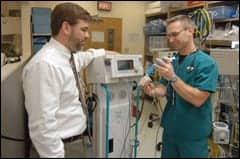Lung transplant patients who took part in a 3-month structured exercise program when they were discharged from hospital improved their health-related quality of life and reduced their risk of cardiovascular problems, according to a new study published in the American Journal of Transplantation.
Recent research by the authors showed that transplant patients often remain inactive after surgery. Up to half also develop illnesses such as osteoporosis, high cholesterol levels, and diabetes, with around 90% developing high blood pressure—all health problems that can be prevented by a physically active lifestyle.
"We were keen to explore whether an exercise training intervention would be capable of partially reversing these remaining limitations in muscle function, enabling patients to improve exercise capacity and increase their participation in daily activities," said Daniel Langer, MD, from the faculty of kinesiology and rehabilitation sciences and the respiratory rehabilitation and respiratory division at University Hospitals KU Leuven
Forty patients who had not experienced complications after single or double lung transplants were randomly allocated to two groups, with 21 patients taking part in a 3-month exercise initiative and the other 19 forming the control group. Demographics for both groups, who had an average age of 59, were similar.
Patients in the intervention group exercised three times a week following their discharge from hospital, with each session lasting about 90 minutes. The training included cycling, walking, stair climbing, and resistance exercise using leg press equipment. Exercise intensity increased during the 3-month training program. The control group did not take part in the training regime. However, all the patients took part in daily mobility exercises in hospital after surgery, for an average of 6 weeks. This included walking, cycling, stair climbing, and resistance exercises.
The authors compared daily walking, physical fitness, quality of life, and ill health from cardiovascular disease between the two groups. This included monitoring their blood pressure during normal activities over a 24-hour period. They found that 1 year after hospital discharge 18 patients remained in the intervention group, with 16 in the control group. Five patients were lost to severe medical complications, and one was unwilling to continue. After a year, the patients in the intervention group were walking an average of 85 minutes a day (plus or minus 27 minutes), while the control group were walking an average of 54 minutes a day (plus or minus 30 minutes). Quadriceps muscle force—how far the patients could walk in 6 minutes—and self-reported physical functioning were significantly higher in the patients who exercised. Average 24-hour diastolic and systolic blood pressure was significantly lower in the treated patients.
The patients who took part in the exercise achieved better physical fitness against a number of key measures, reported better physical functioning, and had lower blood pressure and better cardiovascular health than the patients in the control group, according to the authors.
Source: Wiley-Blackwell









